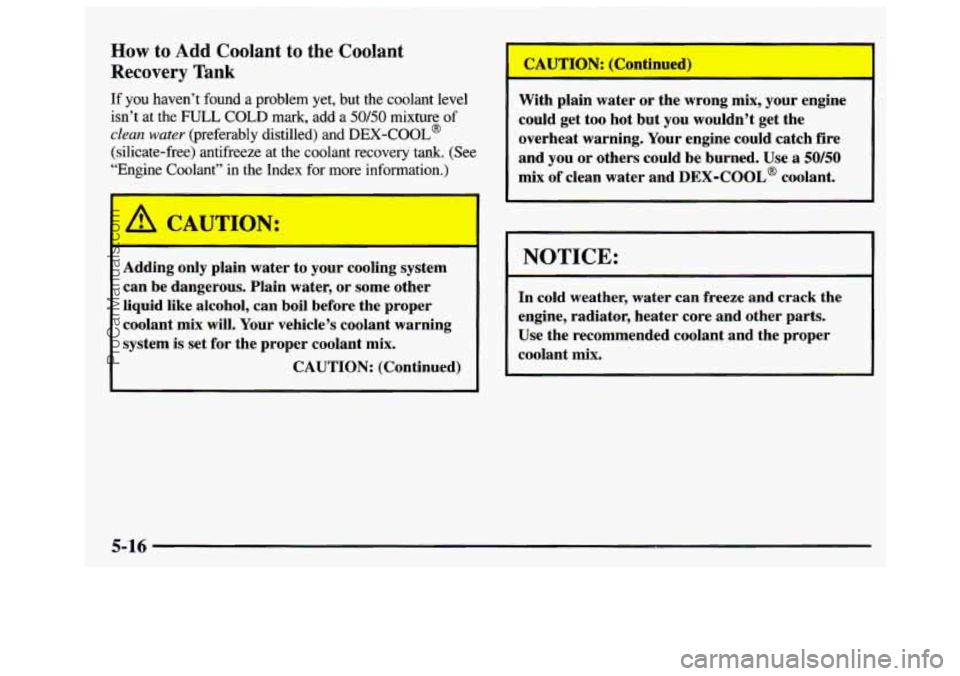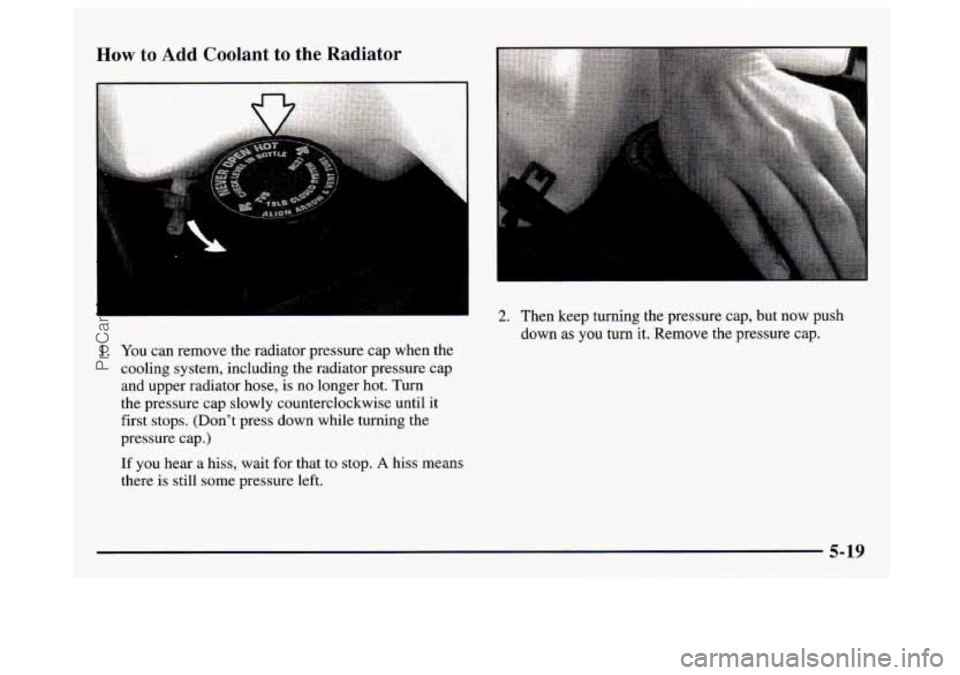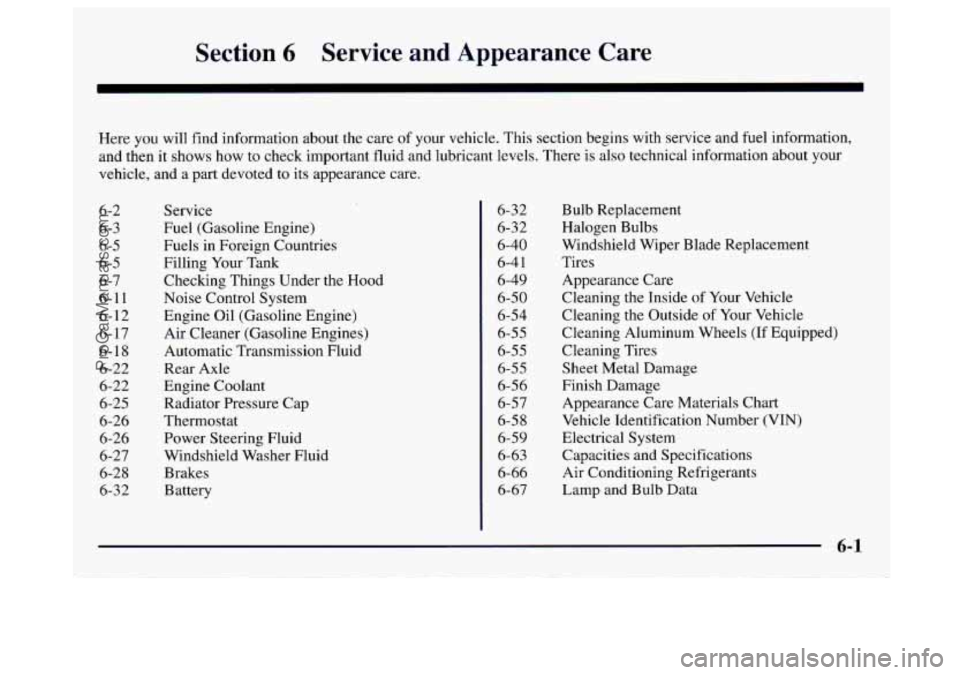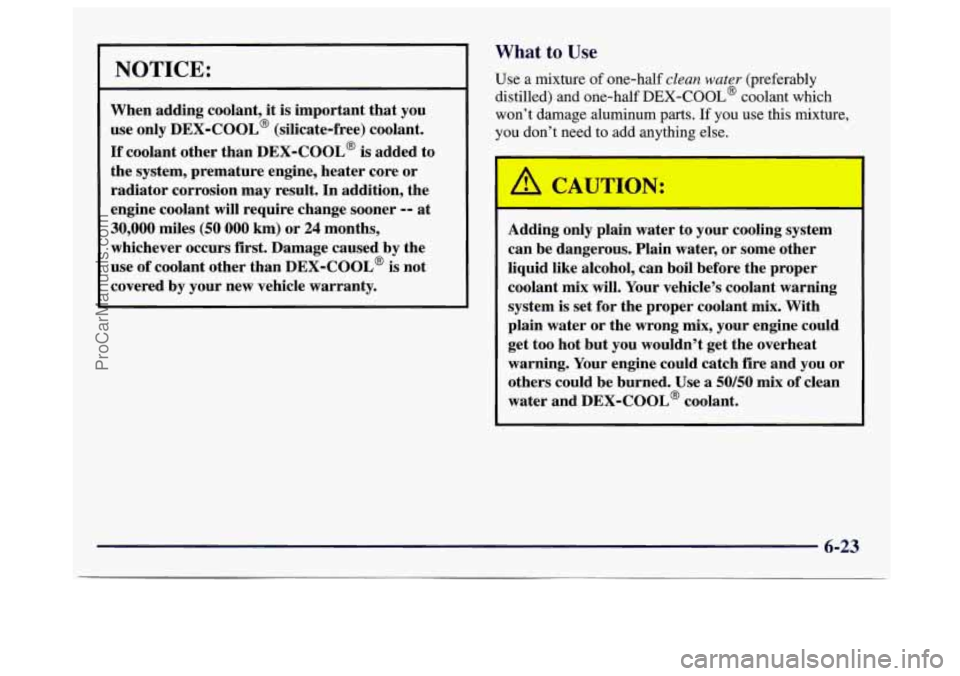radiator GMC SAVANA 1997 Owners Manual
[x] Cancel search | Manufacturer: GMC, Model Year: 1997, Model line: SAVANA, Model: GMC SAVANA 1997Pages: 388, PDF Size: 20.17 MB
Page 208 of 388

Cooling System
When you decide it’s safe to lift the hood, here’s what
you’ll see:
The coolant level should be at or above the
FULL
COLD mark.
A. Radiator pressure cap
B. Coolant recovery tank
C. Engine fan(s)
If the coolant inside the coolant recovery tank is boiling,
don’t do anything else until it cools down.
5-14
I I
ProCarManuals.com
Page 209 of 388

If it isn’t, you may have a leak in the radiator hoses,
heater hoses, radiator, water pump or somewhere else in
the cooling system.
A CAUTION:
Heater and radiator hoses, and other engine
parts, can be very hot. Don’t touch them.
If you
do, you can be burned.
Don’t run the engine
if there is a leak. If you run
the engine, it could lose a11 coolant. That could
cause an engine fire, and
you could be burned.
Get any leak fixed before
you drive the vehicle.
NOTICE:
Engine damage from running your engine
without coolant isn’t covered
by your warranty.
If there seems to be no leak, start the engine again. See
if the fan speed increases when idle speed is doubled by
pushing the accelerator pedal down.
If it doesn’t, your
vehicle needs service. Turn off the engine.
5-15
ProCarManuals.com
Page 210 of 388

How to Add Coolant to the Coolant
Recovery Tank
If you haven’t found a problem yet, but the coolant level
isn’t at the
FULL COLD mark, add a 50/50 mixture of
clean water (preferably distilled) and DEX-COOL@
(silicate-free) antifreeze
at the coolant recovery tank. (See
“Engine Coolant” in the Index for more information.)
Adding only plain
can be dangerous. Plain water,
or some other
liquid like alcohol, can boil before the proper
coolant mix will, Your vehicle’s coolant warning
system is set for the proper coolant mix.
CAUTION: (Continued) JAUTION:
(Continu
With plain water or the wrong’mix, your engine
could get too hot but you wouldn’t get the
overheat warning. Your engine could catch fire
and you or others could be burned. Use
a 50/50
mix of clean water and DEX-COOL@ coolant.
NOTICE:
In cold weather, water can freeze and crack the
engine, radiator, heater core and other parts.
Use the recommended coolant and the proper
coolant mix.
5-16
ProCarManuals.com
Page 211 of 388

’ 1 CAUTION:
You can be burned if you spill coolant on hot
engine parts. Coolant contains ethylene glycol and
it will burn if the engine parts are hot
enough. Don’t spill coolant
on a hot engine.
When the coolant in the coolant recovery tank is at the
FULL COLD mark, start your vehicle.
If the overheat warning continues, there’s one more
thing you can try. You can add the proper coolant mix
directly to the radiator, but be sure the cooling system is
cool before you do it.
5-17
ProCarManuals.com
Page 212 of 388

uu
Steam a--l scalding liquids from a hot cooling
system can blow out and burn you badly. They
are under pressure, and if you turn the pressure
cap
-- even a little -- they can come out at high
speed. Never turn the cap when the cooling
system, including the radiator pressure cap,
is
hot. Wait for the cooling system and radiator
pressure cap to cool if you ever have to turn the
pressure cap.
5-18
ProCarManuals.com
Page 213 of 388

How to Add Coolant to the Radiator
1. You can remove the radiator pressure cap when the
cooling system, including the radiator pressure cap and upper radiator hose,
is no longer hot. Turn
the pressure cap slowly counterclockwise until
it
first stops. (Don't press down while turning the
pressure cap.)
If you hear a hiss, wait for that to stop.
A hiss means
there is still some pressure left.
2. Then keep turning the pressure cap, but now push
down as
you turn it. Remove the pressure cap.
ProCarManuals.com
Page 214 of 388

3. Fill the radiator with the proper DEX-COOL@
coolant mixture, up to the base of the filler neck.
4. Then fill the coolant recovery tank to the FULL
COLD mark.
5. Put the cap back on the coolant recovery tank, but
leave the radiator pressure cap off.
5-20
ProCarManuals.com
Page 215 of 388

6. Start the engine and let it run until you can feel the
upper radiator hose getting hot. Watch out for the
engine fan.
filler neck may be lower. If the level is lower, add
more of the proper
DEX-COOL@ coolant mixture
through the filler neck until the level reaches
the
base of the filler neck.
7. By this time, the coolant level inside the radiator
8. Then replace the pressure cap. At any time during
this procedure if coolant begins to
flow out of the
filler neck, reinstall the pressure cap. Be sure the
arrows
on the pressure cap line up like this.
5-21
ProCarManuals.com
Page 235 of 388

Section 6 Service and Appearance Care
Here you will find information about the care of your vehicle. This section begins with service and fuel information,
and then it shows how
to check important fluid and lubricant levels. There is also technical information about your
vehicle, and a part devoted to its appearance care.
6-2
6-3
6-5
6-5
6-7
6-1 1
6-12 6-17
6-18 6-22
6-22
6-25
6-26
6-26
6-27
6-28
6-32 Service
Fuel (Gasoline Engine)
Fuels in Foreign Countries
Filling Your Tank
Checking Things Under the
Hood
Noise Control System
Engine Oil (Gasoline Engine)
Air Cleaner (Gasoline Engines)
Automatic Transmission Fluid
Rear Axle
Engine Coolant Radiator Pressure Cap
Thermostat Power Steering Fluid
Windshield Washer Fluid Brakes
Battery 6-32
6-32
6-40
6-4
1
6-49
6-50
6-54
6-55
6-55 6-55
6-56
6-57
6-5
8
6-59
6-63
6-66
6-67 Bulb
Replacement
Halogen Bulbs
Windshield Wiper Blade Replacement
Tires
Appearance Care
Cleaning the Inside of Your Vehicle
Cleaning the Outside
of Your Vehicle
Cleaning Aluminum Wheels
(If Equipped)
Cleaning Tires Sheet Metal Damage
Finish Damage
Appearance Care Materials Chart
Vehicle Identification Number (VIN)
Electrical System
Capacities and Specifications
Air Conditioning Refrigerants
Lamp and Bulb Data
ProCarManuals.com
Page 257 of 388

NOTICE:
When adding coolant, it is important that you
use only
DEX-COOL@ (silicate-free) coolant.
If coolant other than DEX-COOL@ is added to
the system, premature engine, heater core or
radiator corrosion may result. In addition, the
engine coolant will require change sooner
-- at
30,000 miles (50 000 km) or 24 months,
whichever occurs
first. Damage caused by the
use of coolant other than DEX-COOL@
is not
covered by your new vehicle warranty.
What to Use
Use a mixture of one-half clean water (preferably
distilled) and one-half
DEX-COOL@ coolant which
won’t damage aluminum parts.
If you use this mixture,
you don’t need to add anything else.
Adding only plain water to your cooling system
can be dangerous. Plain water, or some other
liquid like alcohol, can boil before the proper
coolant mix will. Your vehicle’s coolant warning
system is set for the proper coolant mix. With
plain water or the wrong mix, your engine could
get too hot but you wouldn’t get the overheat
warning. Your engine could catch fire and
you or
others could be burned. Use a
50/50 mix of clean
water and DEX-COOL@ coolant.
6-23
ProCarManuals.com